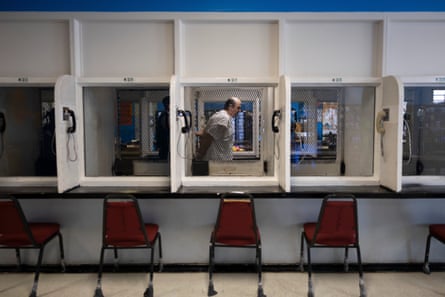At 6pm next Thursday, barring a last-minute reprieve, Robert Roberson will become the first person in America to be executed under the theory of “shaken baby syndrome”, a medical diagnosis from the 1970s that is so disputed it is now widely denounced as junk science.
Roberson, 58, will enter the death chamber at the Huntsville unit in Texas, where he will be strapped to a gurney and injected with a cocktail of lethal drugs. He will be put to death having been convicted of shaking to death his two-year-old daughter Nikki Curtis in 2002.
A coalition of advocates is calling for the execution to be called off, arguing Roberson is innocent of a crime that never even happened. They include several people exonerated from shaken baby syndrome convictions; more than 80 bipartisan Texas lawmakers; the lead detective in Roberson’s original investigation; and members of his trial jury.
Roberson’s lawyer, Gretchen Sween, told the Guardian that not only was her client’s life in the balance – so too was justice. “If Robert is executed next week, with all that is known about the profound due-process problems on top of his actual innocence, then Texas would have no legitimate justice system.”
She added: “How could you have confidence in a system that cannot fix a case like this, where the science has been so thoroughly discredited?”
A year ago, Roberson came within two hours of dying by lethal injection and was only saved by a frenzied late-night intervention by Texas legislators. In an interview with the Guardian from death row shortly before that execution date, he denied having shaken his daughter.
“I don’t know what happened to her,” he said. “I wouldn’t want that to be on nobody: to lose a child, especially if you tried to do right and you loved her and tried to get to know her, then to be accused.”
Now Sween and Roberson’s legal team are scrambling yet again to prevent him becoming a statistic – as the first person on death row to be judicially killed on the back of disputed shaken baby syndrome.
Last week his defense team petitioned the US fifth circuit court of appeals requesting a federal review of new evidence that points to an alternative explanation for Nikki’s death. The petition includes expert testimony from 10 medical pathologists who question the findings of Nikki’s 2002 autopsy.
The experts conclude that the child’s brain swelling was not caused by violent shaking, but was the result of serious infection. Nikki had undiagnosed pneumonia at the time she slumped into a coma, according to the experts, exacerbated by improper prescription of dangerous medicines and a short fall from the bed in which she was sleeping.
The petition also highlights that a few years ago Roberson was found to have autism, a condition which had gone undiagnosed at the time of his daughter’s death. His lawyers argue that this helps explain how flat and unemotional he appeared when he brought the dying girl into hospital, a demeanor that was used against him at trial as evidence of guilt.
A separate petition has been pending for eight months at the state’s top criminal court, the Texas court of criminal appeals. The 163-page document filed by Roberson’s lawyers in February argues that science behind shaken baby syndrome had been so undermined by new evidence that today “no rational juror would find Roberson guilty of capital murder”.
A decision from the court is expected any day.
Last year, the same criminal appeals court overturned the 35-year sentence of Andrew Roark, who had been found guilty of injuring his girlfriend’s 13-month-old child in 1997. The judges found that key scientific testimony at Roark’s trial had been unreliable, and concluded that if it were presented to a jury today it would “likely yield an acquittal”.
There are glaring similarities between the Roark case and Roberson’s conviction. Both men became the subject of shaken baby syndrome accusations on the back of a diagnosis from the same child abuse specialist, Janet Squires, delivered from the same hospital.
“The similarities between the cases are overwhelming,” Sween said.
The attorney general of Texas, Ken Paxton, continues to stand by Roberson’s death sentence, describing the efforts of the condemned man’s supporters as “11th-hour, one-sided, extrajudicial stunts that attempt to obscure facts and rewrite his past”.
In an unusual move, Paxton secured next week’s execution date while the prisoner’s petition was still pending before the appeals court.
Some of Nikki’s other family members are also pressing for the execution to go ahead.
Shaken baby syndrome (SBS), which often now goes under the name “abusive head trauma”, was developed in the early 1970s to diagnose children who became severely ill or died from internal brain injuries without necessarily showing outward signs of harm. One of its earliest proponents was the British pediatric neurosurgeon Norman Guthkelch.

By the 1980s the theory had hardened into the presumption that a triad of symptoms in children under two years old conclusively indicated abusive shaking. If those three symptoms were indicated – brain swelling, bleeding between the tissues covering the brain, and bleeding behind the eyes – then a crime must have been committed.
In the past 15 years medical understanding has grown. It is now widely recognised that other factors can lie behind such brain injuries, including underlying conditions, infections, and even relatively short falls.
Studies have also shown that it is physically unlikely that severe brain trauma is caused by shaking alone, without there also being visible injuries to the spine or skull. In Roberson’s case, Nikki displayed no such injuries.
Guthkelch himself warned in 2012 that the three symptoms he had identified should not be taken as categoric signs of abuse. “There was not a vestige of proof when the name was suggested that shaking, and nothing else, causes the triad,” he said.
In 2023 a group of global experts drawn from many disciplines including pediatrics, pathology, ophthalmology, neurology, physics and biomechanics reviewed the literature on SBS. Their work was published as a book, Shaken Baby Syndrome: Investigating the Abusive Head Trauma Controversy.
The book’s co-editor, Keith Findley, said that “we consistently reached the conclusion that the scientific underpinnings for shaken baby syndrome are just not there. This is not to deny that abuse happens. It’s to say that medical findings alone simply cannot be a reliable basis for diagnosing child abuse.”
Findley, who is founder of the Center for Integrity in Forensic Sciences, said: “It is absolutely horrifying to think we are days away from killing a man based on scientific assertions that are known to be wrong”.
As medical doubts have grown about the reliability of an SBS diagnosis, so too have concerns about its application in criminal cases. Since 1989, 39 parents and caregivers have been exonerated in the US having been convicted largely on the grounds of a faulty SBS hypothesis, according to the National Registry of Exonerations.
Two of those exonerations were in Texas, including Roark’s last November.
Josh Burns, 49, is an SBS exoneree. In 2014, when he was working as a Delta Air Lines pilot and living in Michigan, his daughter Naomi suffered a bout of vomiting and he was accused of having harmed her by violent shaking.
The girl was taken into foster care, and he was convicted of child abuse and spent a year in jail. It took him 10 years to clear his name.
An investigation by the state’s conviction integrity unit last year concluded there had been no reliable evidence of harm. Naomi’s symptoms could be explained by dehydration caused by a stomach bug.
Burns and his family paid a devastating price for his wrongful conviction. He lost his job as a pilot, and his family was forced to move out of Michigan – ironically, they ended up in Texas, where Roberson is now scheduled to be executed.
“I know how gut-wrenching and soul-crushing it is to be accused of harming the person that you love the most,” Burns told the Guardian. He has joined other SBS exonerees to campaign for a reprieve for Roberson, viscerally aware that there is a critical difference between his plight and Roberson’s.
“You can undo a wrongful conviction like mine,” he said. “But you cannot undo a wrongful execution.”
Audrey Edmunds, 64, has also joined the campaign to save Roberson. She was babysitting a neighbor’s child, Natalie, in Wisconsin in 1995 when the girl fell ill and died.
She was convicted a year later of first-degree reckless homicide under the SBS hypothesis. At trial key facts, including that Natalie had visited the doctor 24 times in the 27 weeks before her death, were glossed over.
Edmunds served 11 years of an 18-year sentence, before the forensic pathologist in her case recanted his own testimony having taken on board changes in scientific understanding. In 2008 she was released and all charges against her dismissed.
“Mr Roberson should never have been put on death row,” Edmunds said. “Executing him would be a crime. He has been through more than enough.”
She said that she saw strong parallels between her case and Roberson’s. “They checked into junk science. They went down a one-way road, and didn’t look at all the other factors.”
Texas was the first state in the country to allow prisoners to challenge their sentences on grounds of junk science. Since its inception in 2013, the so-called “junk science writ” has been taken up by about 70 death row prisoners.
None of their challenges have been successful.

 German (DE)
German (DE)  English (US)
English (US)  Spanish (ES)
Spanish (ES)  French (FR)
French (FR)  Hindi (IN)
Hindi (IN)  Italian (IT)
Italian (IT)  Russian (RU)
Russian (RU)  3 weeks ago
3 weeks ago
























Comments